St George in the East, Middlesex
Up to 1834
St George in the East had a parish workhouse situated between Prusom Street and Princes Street (now Raine Street), Wapping. In May, 1820, The following adverstisement appeared in the Public ledger and Daily Advertiser.
On November 5th, 1823, a serious fire broke out at the workhouse. The blaze began in a room where inmates were employed in picking oakum and above which were several sleeping rooms. There were over 400 individuals on the premises who were rushed out into the yard and street. The parish fire engine soon arrived and set to directing water onto the conflagration. A search of the wards over the oakum room revealed four females who had been deprived of life, suffocated by smoke. One of these, it was said, had escaped in a state of nudity but had returned for her clothes and in consequence fell victim to her modesty. The body of a male inmate was subsequently recovered.
After 1834
On 25th March, 1836, the parish of St George in the East was constituted as a Poor Law parish under the 1834 Poor Law Amendment Act. Its operation was overseen by an elected Board of 18 Guardians. The population of the parish at the 1831 census had been 38,505 and the average poor-relief expenditure for the years 1833-5 was £17,706 or 9s.2d. per head.
The former parish workhouse continued in use, and in 1838 the Poor Law Commissioners authorized an expenditure of £2,000 on its enlargement. Males were housed at the north of the site and females at the south. An infirmary lay at the south-east corner of the site. Premises at the west side of Prince's Street also housed the receiving wards, workshops, and dispensary. The workhouse location and layout are shown on an 1875 map below:
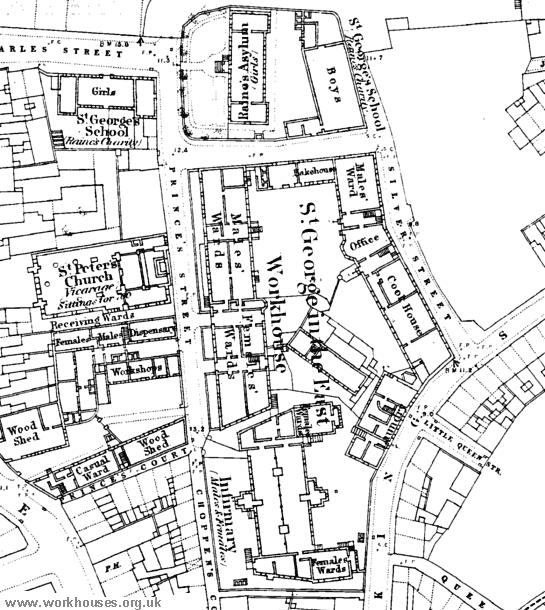
St George in the East workhouse site, 1875.
The workhouse site expanded at the east side on land owned by Raine's Charity. The charity's St George's School site, at the north of the workhouse, was subsequently also tken over and used for additional male wards.
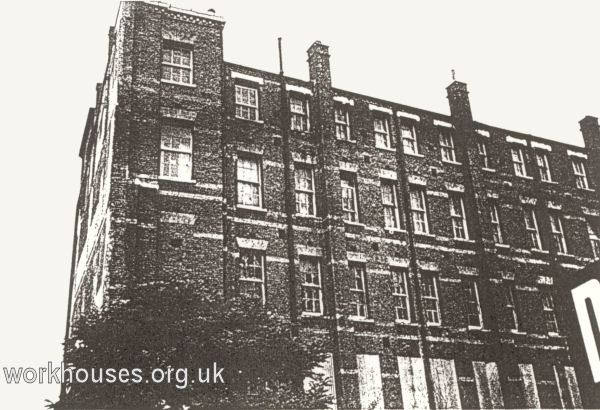
St George in the East, male dormitories.
In 1925, St George in the East joined the Stepney Poor Law Union. After being taken over the London County Council in 1930, the workhouse became the St George In the East Hospital.
The hospital closed in 1956 and for a short time housed refugees from the Hungarian uprising in that year. Almost all the buildings were demolished in 1963, the sole survivor being the male ward block at the north side of Farthing Fields.
Plashet Industrial School
In 1851, St George in the East opened an industrial school on a sixteen-acre site at the east side of GipsyLane (now Green Street) in Plashet. It was intended to accommodate 150 boys, 120 girls and 80 infants.
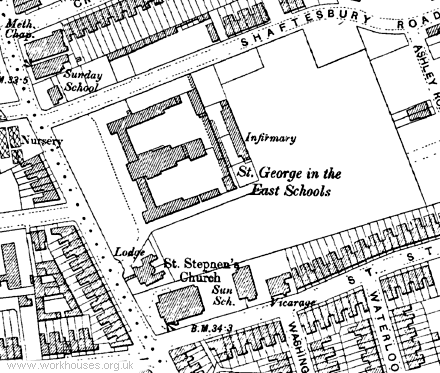
Plashet School site, 1896.
The school closed in around 1927 and the buildings was sold to a cinema chain who remodeled the building and reopened it in 1928 as the Carlton Cinema. It later became the ABC and then the Ace cinema, finally closing in 1983. The building has now been demolished and the site is used as a car park.
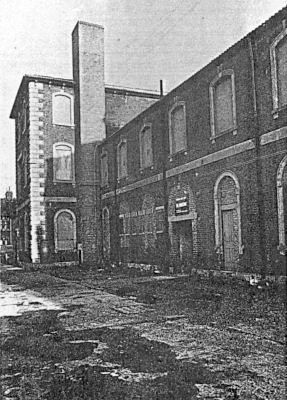
Plashet former school building, 1970s.
Raymond Street Casual Ward
St George in the East operated a casual ward for vagrants on Raymond Street in Wapping.
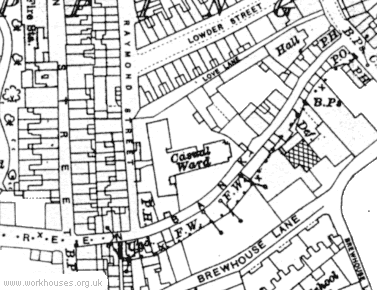
St George in the East casual ward site, 1914.
Staff
Inmates
- Long-term workhouse inmates (1861)
- 1881 Census — Princes Street workhouse
- 1881 Census — Princes Street workhouse infirmary
Records
Note: many repositories impose a closure period of up to 100 years for records identifying individuals. Before travelling a long distance, always check that the records you want to consult will be available.
-
The
Ancestry UK
website has two collections of London workhouse records (both name searchable):
- Westminster workhouse records are available on FindMyPast, .
-
London Metropolitan Archives, 40 Northampton Road, London EC1R OHB.
Holdings include: Guardians' minutes (1836-1924); Committee minutes (1907-17); Staff records (1876-1926).
- Raine Street Workhouse — Admissions and discharges (1814-1921, with gaps); Creed registers (1864-1921); Births registers (1854-75); Deaths registers (1836-1918); etc.
- Raine Street Infirmary — Admissions and discharge registers (1871-1925); Births registers (1871-1915); Deaths registers (1889-1916); Creed registers (1872-89); etc.
- Plashet School — Admission and discharge registers 1856-1925; Lists of pauper children (1859-1920); Creed registers (1906-1925).
- Mr Drouet's Home, Tooting — Lists of pauper children (1852-61).
Bibliography
- Higginbotham, Peter Workhouses of London and the South East (2019)
Links
- None.
Unless otherwise indicated, this page () is copyright Peter Higginbotham. Contents may not be reproduced without permission.


